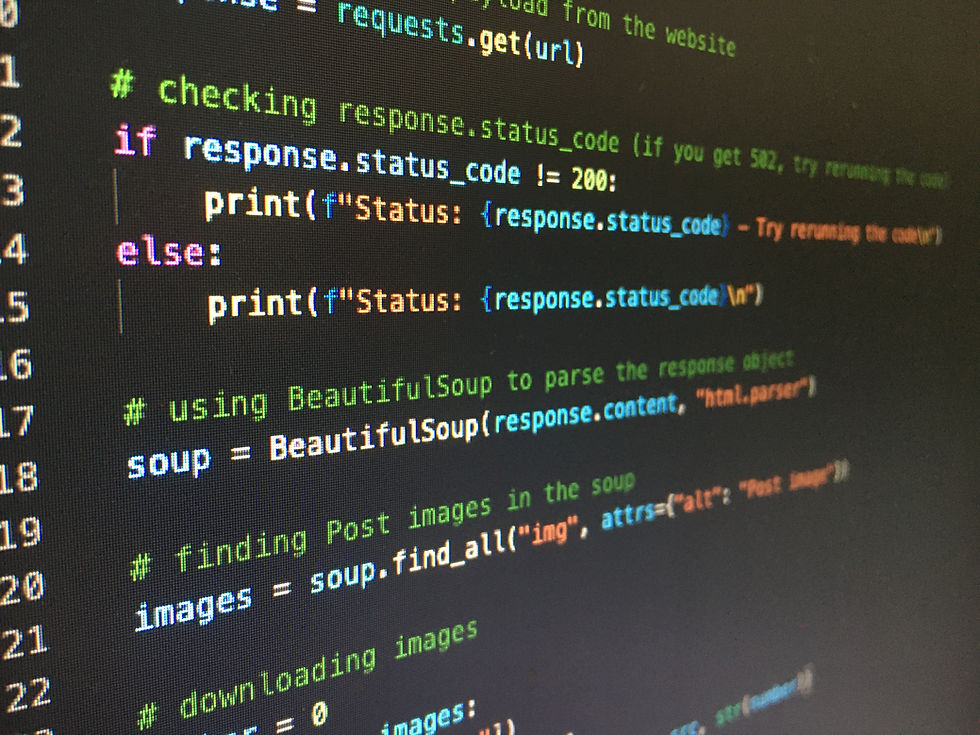The Incredible Growth of Python
- papaki laou
- May 24, 2022
- 6 min read
We as of late investigated how rich nations (those characterized as big time salary by the World Bank) will generally visit an alternate arrangement of innovations than the remainder of the world. Among the biggest contrasts we saw was in the programming language Python. At the point when we center around big league salary nations, the development of Python is considerably bigger than it…
Symbol for David Robinson

David Robinson
TRENDING - Python for beginners
Information Scientist (previous)
We as of late investigated how rich nations (those characterized as big time salary by the World Bank) will generally visit an alternate arrangement of innovations than the remainder of the world. Among the biggest contrasts we saw was in the programming language Python. At the point when we center around big time salary nations, the development of Python is significantly bigger than it could show up from apparatuses like Stack Overflow Trends, or in different rankings that think about worldwide programming improvement.
Here, we'll investigate the unprecedented development of the Python programming language over the most recent five years, as seen by Stack Overflow traffic inside top level salary nations. The expression "quickest developing" can be difficult to characterize unequivocally, however we put forth the defense that Python has a strong case to being the quickest developing significant programming language.
Every one of the numbers examined in this post are for major league salary nations; they're for the most part illustrative of patterns in the United States, United Kingdom, Germany, Canada, and other such nations, which in blend make up around 64% of Stack Overflow's traffic. Numerous different nations like India, Brazil, Russia, and China additionally make colossal commitments to the worldwide programming advancement environment, and this post is less elucidating of those economies, however we'll see that Python has shown development there also.
It merits underlining front and center that the quantity of clients of a language isn't a proportion of the language's quality: we're depicting the dialects designers use, however not recommending anything. (To be completely honest: I used to program basically in Python, however I have since exchanged altogether to R).
Python's development in major league salary nations
You can see on Stack Overflow Trends that Python has been filling quickly over the most recent couple of years. Be that as it may, for this post we'll zero in on top level salary nations, and consider visits to questions as opposed to questions asked (this will in general give comparable outcomes, however has less month-by-month clamor, particularly for more modest labels).
SEE TODAY - Fundamentals of Linux
We have information on Stack Overflow question sees returning to late 2011, and in this time span we can think about the development of Python comparative with five other significant programming dialects. (Note that this is hence a more limited time scale than the Trends device, which returns to 2008). These are right now six of the ten most-visited Stack Overflow labels in top level salary nations; the four we did exclude are CSS, HTML, Android, and JQuery.
June 2017 was the principal month that Python was the most visited label on Stack Overflow inside big time salary countries. This included being the most visited label inside the US and the UK, and in the main 2 in practically any remaining big time salary countries (close to one or the other Java or JavaScript). This is particularly amazing in light of the fact that in 2012, it was less visited than any of the other 5 dialects, and has developed by 2.5-overlap in that time.
SEE NOW - Python for beginners
A piece of this is a result of the occasional idea of traffic to Java. Since it's vigorously shown in college classes, Java traffic will in general ascent throughout the fall and spring and drop throughout the mid year. Will it find Python again before the year's over? We can take a stab at determining the following two years of development with a model called "STL", which joins development with occasional patterns to make an expectation about future qualities.
TRENDING - Fundamentals of linux
As per this model, Python could either remain leading the pack or be overwhelmed by Java in the fall (it's generally inside the variety of the model's expectations), yet it's plainly on target to turn into the most visited tag in 2018. STL additionally proposes that JavaScript and Java will stay at comparative degrees of traffic among big league salary nations, similarly as they have throughout the previous two years.
What labels are becoming the quickest in general?
The above was checking out just at the six most-visited programming dialects. Among other outstanding advancements, which are presently developing the quickest in big league salary nations?
We characterized the development rate concerning the proportion somewhere in the range of 2017 and 2016 portion of traffic. We chose to think about just programming dialects (like Java and Python) and stages (like iOS, Android, Windows and Linux) in this examination, rather than structures like Angular or libraries like TensorFlow (albeit a considerable lot of those showed outstanding development that might be inspected in a future post).
In light of the difficulties in characterizing "quickest developing" portrayed in this comic, we contrast the development with the general typical in a mean-distinction plot.
With a 27% year-over year-development rate, Python remains solitary as a label that is both enormous and developing quickly; the following biggest label that shows comparable development is R. We see that traffic to most other huge labels has remained pretty predictable inside top level salary nations, with visits to Android, iOS, and PHP diminishing somewhat. We recently analyzed a portion of the contracting labels like Objective-C, Perl and Ruby in our post on the passing of Flash). We can likewise see that among utilitarian programming dialects, Scala is the biggest and developing, while F# and Clojure are more modest and contracting, with in the middle between and staying consistent.
There's a significant exclusion from the above graph: traffic to TypeScript questions developed by a great 142% somewhat recently, enough that we left it off to try not to overpower the remainder of the scale. You can likewise see that a few other more modest dialects are developing in much the same way or quicker than Python (like R, Go and Rust), and there are various labels like Swift and Scala that are additionally showing noteworthy development. How does their traffic over the long haul contrast with Python's?
The development of dialects like R and Swift is without a doubt great, and TypeScript has shown particularly fast extension in a significantly more limited time. Large numbers of these more modest dialects developed from getting basically no inquiry traffic to become remarkable existences in the product biological system. Yet, as this diagram shows, it's simpler to show fast development when a label began moderately little.
Note that we're not saying these dialects are at all "contending" with Python. Rather, we're making sense of for what reason we'd treat their development in a different classification; these were lower-traffic labels to begin with. Python is a strange case for being both one of the most visited labels on Stack Overflow and one of the quickest developing ones. (It just so happens, it is likewise speeding up! Its year-over-year development has become quicker every year starting around 2013).
Rest of the world
Such a long ways in this post we've been dissecting the patterns in major league salary nations. Does Python show a comparable development in the other world, in nations like India, Brazil, Russia and China?
Without a doubt it does.
Beyond big league salary nations Python is as yet the quickest developing significant programming language; it essentially began at a lower level and the development started two years after the fact (in 2014 as opposed to 2012). As a matter of fact, the year-over-year development pace of Python in non-big league salary nations is marginally higher than it is in top level salary nations. We don't look at it here, however R, the other language whose utilization is decidedly connected with GDP, is filling in these nations also.
A considerable lot of the ends here about the development and decline of labels (rather than the outright rankings) in major league salary nations remain constant until the end of the world; there's a 0.979 Spearman relationship between's the development rates in the two sections. At times, you can see a "slacking" peculiarity like what occurred with Python, where an innovation was generally taken on inside top level salary nations a little while before it extended in the remainder of the world. (This is a fascinating peculiarity and might be the subject of a future blog entry!)
In the future
We're not hoping to add to any "language war." The quantity of clients of a language suggests nothing about its quality, and surely can't perceive you which language is more suitable for a specific circumstance. In light of that viewpoint, in any case, we accept it merits understanding what dialects make up the designer biological system, and how that environment may change.
This post exhibited that Python has shown an astonishing development over the most recent five years, particularly inside big league salary nations. In our next post, we'll begin to investigate the "why". We'll portion the development by country and by industry, and look at what different advances will generally be utilized close by Python (to appraise, for instance, the amount of the development has been because of expanded utilization of Python for web improvement versus for information science).
Meanwhile, assuming that you work in Python and are hoping to make the following stride in your profession, here are a few organizations employing Python engineers right presently on Stack Overflow Jobs.



Comments